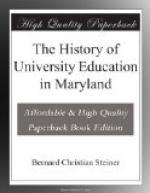But no doubt when we come to modus operandi the main difficulty of the movement is the diversity of the classes it seeks to approach—diversity in individual capacity, in leisure, means, and previous training. Opposite policies have been urged upon us. Some have said: Whatever you do, you must never lower the standard; let the Extension movement present outside the universities precisely the same education as the universities themselves are giving, however long you may have to wait for its acceptance. On the other hand, it has been urged: You must go first where you are most needed; be content with a makeshift education until the people are ready for something better. The movement has accepted neither of these policies, but has made a distinction between two elements of university training—method and curriculum. So far as method is concerned we have considered that we are bound to be not less thorough, but more thorough, if possible, than the universities themselves, in proportion as our clients work under peculiar difficulties. But in the matter of curriculum we have felt it our first duty to be elastic, and to offer little or much as may in each case be desired. Accordingly, we have elaborated an educational unit—the three months’ course of instruction in a single subject: this unit course we have used all the resources we could command for making as thorough in method as possible; where more than this is desired, we arrange that more in a combination or series of such unit courses. The instruction can thus be taken by retail or wholesale: but in all cases it, must be administered on the same rigorous method.
The key to the whole system is thus the unit course of three months’ instruction in a single subject. The method of such a course is conveyed by the technical terms lecture, syllabus, exercises, class. The lectures are addressed to audiences as miscellaneous as the congregation of a church, or the people in a street car; and it is the duty of the teacher to attract such miscellaneous audiences, as well as to




